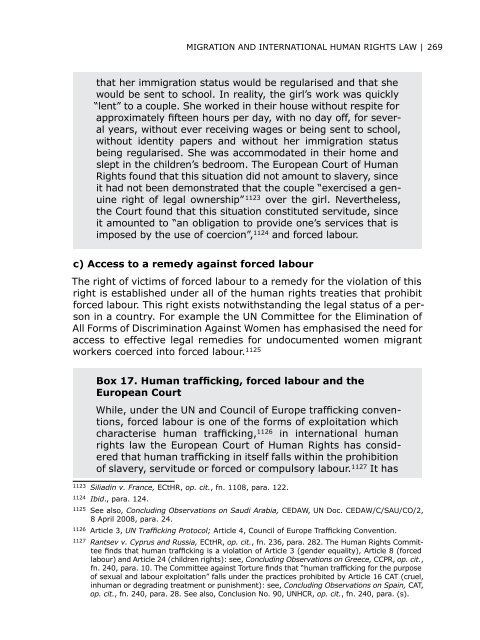Universal-MigrationHRlaw-PG-no-6-Publications-PractitionersGuide-2014-eng
Universal-MigrationHRlaw-PG-no-6-Publications-PractitionersGuide-2014-eng
Universal-MigrationHRlaw-PG-no-6-Publications-PractitionersGuide-2014-eng
You also want an ePaper? Increase the reach of your titles
YUMPU automatically turns print PDFs into web optimized ePapers that Google loves.
MIGRATION AND INTERNATIONAL HUMAN RIGHTS LAW | 269<br />
that her immigration status would be regularised and that she<br />
would be sent to school. In reality, the girl’s work was quickly<br />
“lent” to a couple. She worked in their house without respite for<br />
approximately fifteen hours per day, with <strong>no</strong> day off, for several<br />
years, without ever receiving wages or being sent to school,<br />
without identity papers and without her immigration status<br />
being regularised. She was accommodated in their home and<br />
slept in the children’s bedroom. The European Court of Human<br />
Rights found that this situation did <strong>no</strong>t amount to slavery, since<br />
it had <strong>no</strong>t been demonstrated that the couple “exercised a genuine<br />
right of legal ownership” 1123 over the girl. Nevertheless,<br />
the Court found that this situation constituted servitude, since<br />
it amounted to “an obligation to provide one’s services that is<br />
imposed by the use of coercion”, 1124 and forced labour.<br />
c) Access to a remedy against forced labour<br />
The right of victims of forced labour to a remedy for the violation of this<br />
right is established under all of the human rights treaties that prohibit<br />
forced labour. This right exists <strong>no</strong>twithstanding the legal status of a person<br />
in a country. For example the UN Committee for the Elimination of<br />
All Forms of Discrimination Against Women has emphasised the need for<br />
access to effective legal remedies for undocumented women migrant<br />
workers coerced into forced labour. 1125<br />
Box 17. Human trafficking, forced labour and the<br />
European Court<br />
While, under the UN and Council of Europe trafficking conventions,<br />
forced labour is one of the forms of exploitation which<br />
characterise human trafficking, 1126 in international human<br />
rights law the European Court of Human Rights has considered<br />
that human trafficking in itself falls within the prohibition<br />
of slavery, servitude or forced or compulsory labour. 1127 It has<br />
1123 Siliadin v. France, ECtHR, op. cit., fn. 1108, para. 122.<br />
1124 Ibid., para. 124.<br />
1125 See also, Concluding Observations on Saudi Arabia, CEDAW, UN Doc. CEDAW/C/SAU/CO/2,<br />
8 April 2008, para. 24.<br />
1126 Article 3, UN Trafficking Protocol; Article 4, Council of Europe Trafficking Convention.<br />
1127 Rantsev v. Cyprus and Russia, ECtHR, op. cit., fn. 236, para. 282. The Human Rights Committee<br />
finds that human trafficking is a violation of Article 3 (gender equality), Article 8 (forced<br />
labour) and Article 24 (children rights): see, Concluding Observations on Greece, CCPR, op. cit.,<br />
fn. 240, para. 10. The Committee against Torture finds that “human trafficking for the purpose<br />
of sexual and labour exploitation” falls under the practices prohibited by Article 16 CAT (cruel,<br />
inhuman or degrading treatment or punishment): see, Concluding Observations on Spain, CAT,<br />
op. cit., fn. 240, para. 28. See also, Conclusion No. 90, UNHCR, op. cit., fn. 240, para. (s).



